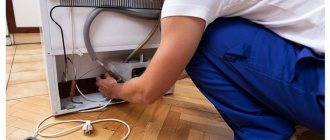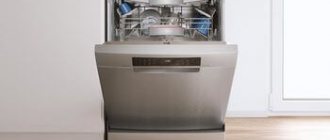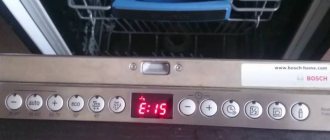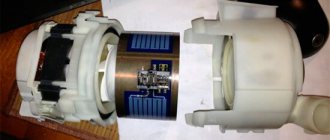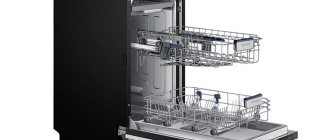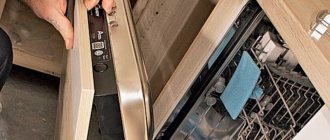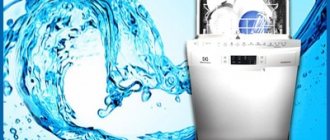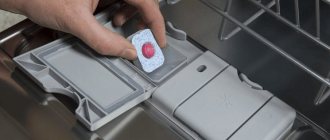During commercial breaks, the following words are heard more and more often from TV screens: “I’m a woman, not a dishwasher.” Therefore, many people began to think about buying a dishwasher for their kitchen. One of the most frequently chosen brands on the market is Bosch. Household appliances from this company have been used by many generations not only of Russians, but also of residents of the rest of the world. Even if you take a responsible approach to the selection and installation of this unit, thoroughly study all the instructions, indicators of the Bosch dishwasher and operating tips, you can still encounter minor or major problems in the operation of this equipment.
Description of controls
In everyday use, a Bosch dishwasher is unlikely to cause much difficulty in use. Many lights and modes remain unused. But to use a Bosch dishwasher comfortably, you need to know what each of the signal indicators means. Let us first consider those that are present on almost all models and indicate various stages of work.
- “End” indicator – indicates the end of the dishwashing cycle.
- “Brush” indicator – lights up when the dishwasher starts.
- “Tap” indicator – signals the period of operation when the cavity of the machine is filled with hot water.
- The “Salt” indicator (two arrows in the shape of the English letter S) - indicates the presence of a salt absorbent, which helps clean the heating element from scale that has formed on it.
- The “Rinse aid” indicator (snowflake, sun, star) indicates the presence of dishwashing liquid in a special compartment.
The keys responsible for setting and regulating the upcoming wash are allocated to a separate category. The functionality of each Bosch model is very different, so only those buttons that are most common will be described.
- “Pan” - this symbol indicates an intensive mode of washing dishes at a temperature of more than 70 degrees Celsius and lasting about an hour. Used for the heaviest stains.
- “Cup and saucers” (or Auto mode) is the standard operating mode. Similar to when we wash dishes by hand. Water temperature - 50 degrees. Duration – up to two hours.
- “Cup and plates” (ECO, economy) – mode of reduced water consumption. It differs from the standard one in the presence of a rinsing stage.
- “Glass (cup) with two arrows” – accelerated washing. It passes in half an hour at a temperature of about 40 degrees Celsius.
- “Glass” – delicate mode. Used for fragile dishes.
- “Baby food bottle” – treatment of dishes with hot water, which destroys germs. Used to disinfect baby supplies (dishes, pacifiers, etc.).
Indicators on the dishwasher - why they light up and what to do about it
An unexpected shutdown or refusal to turn on the dishwasher at first causes slight horror - it’s broken, you’ll have to fix it.
However, you should not immediately be upset if the indicator on the dishwasher is on, everything can end in a slight fright.
Indicators have the same properties on all dishwashers:
- The most common request is that the salt indicator is on in the dishwasher. Usually it signals that the salt has run out (zigzag arrow) and the compartment needs to be refilled. Sometimes the salt indicator may light up even if it is present - in this case, you need to stir the contents of the compartment and close the lid well.
- The rinse aid indicator (snowflake) lights up - the container is empty, you need to pour rinse aid into the compartment.
If you use tablets or 3in1 liquid detergent, you need to press the button with the same name on the body of the machine - the indicators will stop lighting, and the machine will be able to work in a more correct cycle.
Next, let's look at why the indicator lights (buttons) light up in Bosch, Hansa, Ariston and Electrolux dishwashers.
READ MORE: Test mode of Samsung washing machine - service launch
Types of faults
Most problems that can occur with a Bosch dishwasher do not lead to its complete failure. Modern equipment is equipped with sensors that prevent them from starting if any part is in poor condition. The user will be notified of this either by flashing indicators or an error code on the display of the Bosch dishwasher.
Moreover, the exact startup error can only be determined by putting your dishwasher into service mode. To do this, you need to hold down a combination of some indicators on the panel, which is described in the instructions. Those signals that can be seen in normal mode give only an approximate indication of the problem.
Lights up or blinks: what's the difference?
A lit indicator, indicated by a brush pattern, usually does not cause concern to anyone, especially since the Bosch dishwasher most often works properly. Under normal conditions, this indicator notifies the user that the washing process is in progress, and as soon as the dishwashing is completed, it goes out. On some models of Bosch dishwashers, this indicator lights up at the beginning of the wash, and then goes out after some time. This is normal “behavior” of the machine, you don’t have to worry.
The indicator with the image of a brush most often lights up after the start of the washing program and goes out after the washing phase has ended and the drying phase has begun.
This indicator may behave completely differently. It may suddenly start blinking, and the operation of the machine most often stops and freezes until it is restarted. What is the reason for the blinking of the indicator with the image of a brush? In some cases, a system glitch is to blame. It cannot be fixed by simply unplugging the dishwasher. You need to do the following:
- as soon as the indicator flashes, you need to press the program start button and hold it for 3 seconds;
- turn off the dishwasher (to be sure, you can unplug the power cord, completely de-energizing it);
- wait 15 seconds, and then turn on the dishwasher again;
- set the desired washing program and launch it.
Types of errors on devices without a digital display
This type of error is not standardized, so this section will look at some options for displaying it on various panels. In order to find out how to eliminate them, a digital code (for example, E4) will be given at the end, which will be deciphered in the next section. We remind you, do not forget to put your Bosch dishwasher into service mode.
A panel that displays up to three digits:
- 0 - No problem;
- 1 – faulty water supply indicator (E6);
- 2 – error in the water heating system (E01);
- 4 – the reservoir is not filled (E3);
- 8 – breakdown of the thermometer (E2);
- 16 – malfunction of the flow regulator (E4).
Panel (display) with two lines:
- S3 – no problems found;
- A or B – error in receiving data from the aqua sensor (E6);
- E – no signal is received from the flow switch (E4);
- F – water does not enter the working cavity (E3);
- G – flow switch does not stop (E5);
- H – problems with the heating element (E01);
- K – short circuit or wiring fault (E2).
Troubleshooting
If the indicator on a Bosch dishwasher is on, and a brush is drawn to the right of it, this can be said to be a normal situation. But if this same indicator blinks, there is no time for jokes, we can talk about a serious breakdown. First you need to make sure that this is not a system failure by performing a series of simple steps described above. Next you need to check the Aquastop sensor, which is located in the tray under the body of the machine. There is such a sensor in Bosch machines with full and partial protection against leaks, and we need to make sure that it does not stop the operation of the machine.
- Let's try to tilt the machine, first laying a rag next to it.
- If there is water in the pan, it will spill out.
- If you managed to drain the water from the pan, you can restart the machine and make sure that the indicator does not blink for some time.
READ MORE: Error i30 on a dishwasher: what to do and how to fix it
Then 2 situations are possible. In the first case, water will fill the pan again and Aquastop will work again. In this case, you need to look for a leak in the housing. In the second case, the breakdown may not recur if water gets into the pan by accident. One way or another, it will be possible to establish that the cause of the problem was a leak.
If there is no water in the pan, then the Aquastop sensor may simply be “stuck.” You will have to turn off the dishwasher, remove the tray and check the position of the float. Unfortunately, this problem occurs quite often, especially if the dishwasher has been moved or moved.
Notice at what point the indicator starts flashing. If the blinking starts when the machine tries to draw water, the inlet valve may be faulty or the water supply tap to the dishwasher is simply turned off. The latter may seem banal, however, it occurs all the time. Do the following:
- check the water supply to the machine;
- listen again to how the machine draws water (to do this you will have to restart the dishwasher again);
- if there is a slight click, then a buzzing sound, but water still does not flow into the machine, therefore, the inlet valve or its relay is faulty.
In more rare cases, a malfunction occurs in the control module, which cannot issue a command to open/close the intake valve.
The indicator may start flashing after water has been filled into the tank, approximately 10 minutes after the start of washing. In this case, the “symptoms” are the same: first, the “Brush” indicator blinks, then the dishwasher completely stops working. With this “behavior” of the machine, you should pay attention to the garbage filter and sprinklers.
It is necessary to remove and wash the filter, disconnect and check the sprinklers, in the holes of which dirt may accumulate. Moreover, the dirt can be packed so tightly that water cannot even seep through the blockages, much less pass under pressure. This often happens among those who like to make dishwashing detergent at home using mustard. The mustard mass hardens and becomes dense and clogs all the smallest holes in the machine, paralyzing its operation.
READ MORE: We have posted everything you need. Kitchen in Khrushchev, 5.2 sq.m. With refrigerator and dishwasher. – Design for home
The last thing to check is the control board, but we would strongly advise against doing this yourself. It is better to invite a specialist who will quickly and competently carry out diagnostics. We also do not recommend changing the control module yourself without making sure that it is broken. There is no need to make the problem worse.
Types of errors on devices with a digital display
Most modern Bosch dishwashers are equipped with such digital panels. Error indicators will light up on them if the dishwashing process failed to start. This facilitates the diagnostic process, and therefore the speed of repair. It is highly not recommended to repair such complex equipment yourself. Contact the appropriate service center. We remind you, do not forget to put your Bosch dishwasher into service mode.
- Uniform flashing of all indicators – software failure;
- E01 – control unit failure;
- E1, F1 – sensor malfunctions;
- E02 – wiring break;
- E2, F2 – heating errors;
- E03 – drying does not occur;
- E3, F3 – tank is not filled;
- E04 – see E02;
- E4, F4 – malfunction of the spray mechanism;
- E05 – see E01;
- E5, F5 – leakage or overflow of the tank;
- E06 – the chamber is not sealed (problems with the locking mechanism);
- E6, F6 – failure of the incoming water quality sensor;
- E07 – fan failure;
- E7, F7 – drain pipe clogged;
- E8, F8, E08 – low water level;
- E9, F9, E09 – problems with power supply to the heating system;
- E10, F10 – see E03, E07;
- E11, F11 – no data from the temperature sensor;
- E12, F12 – contamination of the heating element with limescale;
- E13, F13 – incoming water temperature is too high;
- E14, F14 – error in the water distribution system;
- E15, F15 – tank leak;
- E16, F16 – valve leakage;
- E17, F17 – the incoming water pressure is too powerful;
- E18, F18 – see E3, E14;
- E19, F19 – malfunction in the system;
- E20, F20 – problems with the pump;
- E21, F21 – see E3, E20;
- E22, F22 – drain system clogged;
- E23, F23 – breakdown of the pump responsible for removing water from the tank;
- E24, F24, E25, F25 – see E22;
- E26, F26 – flow sensor failure;
- E27, F27 – problems with the electrical network;
- E28, F28 – see E6;
- E29, E30, F29, F30 – see E27.

